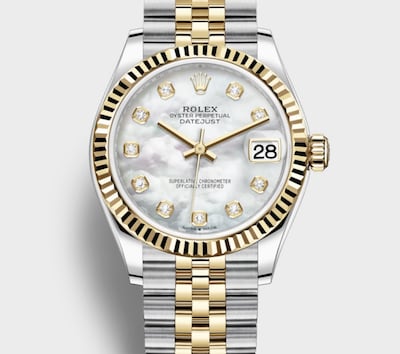The Datejust 31: the latest iteration of an icon
The Watches of Switzerland Group | 3 minute read

German-born British entrepreneur Hans Wilsdorf was just 24 when he founded Rolex, driven by the ambition of making reliable, elegant wristwatches. Forty years later, in 1945, his now-flourishing company launched the Datejust, which would go on to become one of its most popular models of all time. The first automatic timepiece in the world with a date window, it was equipped with a specially designed Jubilee bracelet – a feature that’s a Rolex signature to this day. A decade on, the brand adapted the Datejust’s date-change mechanism so it would alter instantaneously, adding a cyclops lens over the aperture later to magnify the date for easier reading. Today, the Datejust is a horological icon, and the 31mm Oystersteel and yellow-gold version (£11,150) pictured above demonstrates why it so richly deserves that accolade.
A super-accurate hairspring
The Oystersteel and yellow-gold Datejust 31 houses Calibre 2236, Rolex’s new automatic movement with an approximate 55-hour power reserve. It’s fitted with the brand’s patented silicon Syloxi hairspring, which remains 10 times more precise than a traditional steel hairspring even when exposed to shocks, magnetism and temperature fluctuations. Its clever construction makes it gravity-resistant too, meaning it maintains its equilibrium and therefore regularity in any position, making it a highly reliable timepiece for everyday wear.
An array of world-first features
Visually, the Datejust’s stand-out feature is undoubtedly the aforementioned cyclops lens. It’s one of the most distinctive Rolex features, and among the most recognisable. While the Datejust has had a date aperture since 1945, the cyclops lens wasn’t a feature until 1953. Wilsdorf is believed to have come up with the idea after a drop of water landed on his watch, magnifying part of the dial. Speaking of water, Rolex’s famous Oyster case, invented back in 1926, was another world first for the brand. It has a patented screw-down bezel, case back and winding crown. The 31mm Oystersteel and yellow-gold Datejust not only benefits from those sureties, making it water-resistant to 100m, but its winding crown also incorporates Rolex’s Twinlock double-waterproof system.
A host of case and dial options
The Datejust is available in three variations of Rolex’s Rolesor, its two-tone patented combination of stainless steel and either white, yellow or Everose gold, the last of these being the brand’s proprietary fade-proof alloy of 18-carat rose gold, copper and platinum. Ever the pioneer, Rolesor has featured in its collections since the 1930s and was first seen on the Datejust in 1948. Many versions feature the model’s renowned fluted bezel, some with diamond embellishment, and are either set on Rolex’s famously supple five-piece link Jubilee bracelet or Oyster bracelet, fitted with the brand’s concealed Crownclasp or Oysterclasp. The choice of dial materials and colours is equally broad. This Oystersteel and yellow-gold version shimmers with mother-of- pearl, offset with diamond-dot hour markers. Because no example is the same – it can differ in colour, intensity and structure depending on what part of the shell it was extracted from – uniqueness is mother-of-pearl’s USP. Just the thing for those seeking a truly one-and-only watch.
